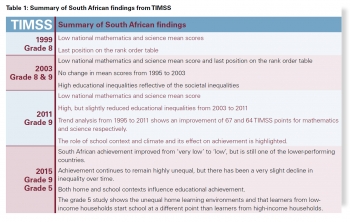TIMSS in South Africa: Making global research locally meaningful
The Trends in International Mathematics and Science Study (TIMSS) assesses the quality of mathematics and science education on an international scale. TIMSS is one of the most established studies of educational quality worldwide, providing information on learners, their schools and home environments; and how these relate to mathematics and science achievement. In South Africa, the HSRC conducts the TIMSS research in collaboration with the Department of Basic Education and the International Association for the Evaluation of Educational Achievement. Dr Vijay Reddy explains the importance of TIMSS.
Learner performance in school mathematics and science are proxy indicators of the health of our educational system. We recognise that the poor performance in these areas continues to contribute to unequal access to the labour market and income. Any change in school mathematics and science performance provides a measure of the extent of transformation since the inception of the democratic state. TIMSS, with its rigorous methodology to measure trends over the last 20 years, allows us an opportunity to track educational progress in the country.
South Africa participated in TIMSS at the grade 8 or 9 level in 1995, 1999, 2003, 2011 and 2015 and in the grade 5 mathematics study, for the first time in 2015. The TIMSS grade 8/9 information provides a unique opportunity for South Africa to monitor the achievement trends and hence the health of our education system since 1995. TIMSS at the grade 5 level provides a new indicator of educational achievement at an earlier stage of educational progress. South Africa will participate in TIMSS 2019 at the grade 9 and grade 5 level.
Table 1 summarises the key findings from the different rounds of TIMSS. For each successive round, the HSRC sought to extend the analysis so that it informs the local context and policies.
One of the key TIMSS-South Africa findings has been the tracking of mathematics and science achievement in the country since 1995. Figure 1 illustrates this using mathematics performance. The science trend follows a similar pattern.
FIGURE 1: TRENDS IN MATHEMATICS ACHIEVEMENT IN TIMMS 1995, 1999, 2003, 2011 AND 2015
We observe that the average national mathematics score remained the same, statistically, over the 1995, 1999 and 2003 cycles. In contrast, from 2003 to 2015 the average mathematics scores improved by 87 points. This change in the South African mathematics achievement scores means that the education system improved from a ‘very low’ (1995, 1999, 2003) to a ‘low’ (2011, 2015) national average.
Although South Africa is still one of the lower performing TIMSS countries, from 2003 to 2015 the country has shown the largest positive improvement of all participating countries in mathematics. We recognise that South Africa started from a very low base and thus had the greater potential to improve.
The highest achievement gains were at the lower end of the distribution. For grade 9 learners, scores at the 5th percentile shifted from 152 in 2003 to 242 in 2015, an improvement of almost one standard deviation. The score improvement for the lowest performing part of the system is a positive sign and is possibly due to the multiple interventions at both the school and home levels for the poorest groups.
The difference in scores between the 5th and 95th percentile measures the inequality in educational performance. From 1995 to 2003, this range was just over 3.5 standard deviations – reflecting the wide disparities in schools and the society leading to the unequal educational outcomes. From 2003 to 2015, the distribution of scores was still wide, but narrowed slightly from 320 points to 287 points. This indicates that educational inequalities are decreasing, albeit slowly.
The outcome from our participation in TIMSS is that a scientifically rigorous trend methodology shows that the educational system is improving. However, the pace of this change is too slow. The low hanging policy amenable interventions identified in the TIMSS analysis, summarised in the following articles, should be explored to facilitate faster improvement of educational achievement.
Author: Dr Vijay Reddy, national research
co-ordinator for TIMSS-South Africa
vreddy@hsrc.ac.za


